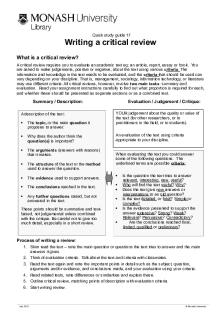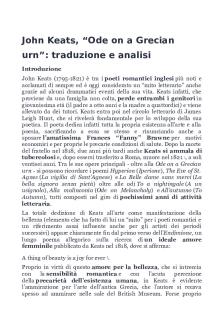A CRITICAL APPRECIATION JOHN KEATS' "ODE TO A NIGHTINGALE" PDF

| Title | A CRITICAL APPRECIATION JOHN KEATS' "ODE TO A NIGHTINGALE" |
|---|---|
| Author | M. Salguero Gómez |
| Pages | 3 |
| File Size | 153.1 KB |
| File Type | |
| Total Downloads | 260 |
| Total Views | 857 |
Summary
A CRITICAL APPRECIATION JOHN KEATS’ “ODE TO A NIGHTINGALE” Minerva Salguero Gómez May 13th, 2020 John Keats wrote Ode to a Nightingale in 1819 and it is an example of Romantic Ode. This ode is the second of a group of five odes, which are: Ode to Psyche, Ode on a Grecian Urn, Ode on Melancholy and O...
Description
Accelerat ing t he world's research.
A CRITICAL APPRECIATION JOHN KEATS' "ODE TO A NIGHTINGALE" Minerva Salguero Gómez English Literature
Cite this paper
Downloaded from Academia.edu
Get the citation in MLA, APA, or Chicago styles
Related papers
Download a PDF Pack of t he best relat ed papers
St ylist ic_ Analysis_ of_ t he_ poem_ Ode_ t o_ Ni.pdf Dest iny Moulder
_ A_ Companion_ t o_ Romant ic_ Poet ry(Book4You).pdf Hasan Zaman St ylist ic Analysis of t he poem " Ode t o Night ingale " by John Keat s Abdul Bari Niazi, Hafsa Shah
A CRITICAL APPRECIATION JOHN KEATS’ “ODE TO A NIGHTINGALE” Minerva Salguero Gómez May 13th, 2020
John Keats wrote Ode to a Nightingale in 1819 and it is an example of Romantic Ode. This ode is the second of a group of five odes, which are: Ode to Psyche, Ode on a Grecian Urn, Ode on Melancholy and Ode on Indolence. An ode is a series of poems called stanzas made by several verse lines. In this case, the poem has 8 stanzas with 10 verse lines each. The Greek term ōdēs means “Choric song” and it was made to commemorate an historic event or the glorious actions of a person. However, in the Romantic period, poets use the ode to glorify the poetry itself or beauty. Accordingly to the literary critic M. H. Abrams: Romantic poets perfected the personal Ode of description and passionate meditation, which is stimulated by […] an aspect of the outer scene and turns on the attempt to solve either a personal emotional problem or a generally human one.1 In this particular ode, we are able to experience a sequence of impressions while the author is embedded and enchanted by the nightingale’s melody. Through the eight stanzas the author exercise his senses, which are excited, and he is able to perceive the beauty in nature and meditate about life, death, and how poetry can transcend time. Specifically, how poetry creates images that can lead to a more profound knowledge. The first sense is taste, which is stimulated by drinking some kind of wine. It helps him to enter into a more sensitive state of mind. Secondly is the hearing, in which he listens to the melody of the nightingale and allows him to experience the landscape, the trees, the sound of the wind moving the leaves. He is aware of all these perceptions as mental images, since he is not capable of seeing every input he perceives: “I cannot see what flowers are at my feet”. It is through the smell that he can guess the flora that surround him: “But, in embalmed darkness, guess each sweet […] the grass, the thicket, the fruittree wild; White hawthorn, and the pastoral eglantine; […] violets cover´d up in leaves; […] musk-rose […]”. The touch is present through textures like softness, lightness, the warm
1
M. H. Abrams, A Glossary of Literary Terms, Heinle & Heinle, Boston, 1999, p.198
temperature and the speaker’s body itself, a body that can feel pain, fatigue, ecstasy, worries. The absence of vision (for example when he mentions “I will fly to thee, […] on the viewless wings of Poesy”) emphasizes the power of meditation to get focused and the capability of the other senses to produce knowledge by a sharpened perception. Sight has been overvalued as the primary sense to get the truth. In this case, the poetic experience is the path to achieve an insight about ephemeral life and the heaviness we have to bear due to our consciousness of mortality. The ode expresses nature’s mysterious beauty. The poet is delighted in admiring the perfection of a natural gesture which is not ruled by men’s law, it escapes human existence, it transcends time and even reality: “Was it a vision, or a waking dream?” the poet wonders at the end of this ode. As a conclusion, we can say that the words of a poet can be as powerful as the melody of a nightingale, if they achieve harmony in a spontaneous gesture, as a painting is expressive when it captures the imprint of the impulsive hand....
Similar Free PDFs

How to Write a Critical Response
- 2 Pages

Critical Essay - Grade: A
- 8 Pages

A and P, john updike
- 3 Pages

17-writing-a-critical-review
- 2 Pages

Dee John-A true faithful relation
- 498 Pages

John Keats-Ode on a Grecian Urn
- 10 Pages
Popular Institutions
- Tinajero National High School - Annex
- Politeknik Caltex Riau
- Yokohama City University
- SGT University
- University of Al-Qadisiyah
- Divine Word College of Vigan
- Techniek College Rotterdam
- Universidade de Santiago
- Universiti Teknologi MARA Cawangan Johor Kampus Pasir Gudang
- Poltekkes Kemenkes Yogyakarta
- Baguio City National High School
- Colegio san marcos
- preparatoria uno
- Centro de Bachillerato Tecnológico Industrial y de Servicios No. 107
- Dalian Maritime University
- Quang Trung Secondary School
- Colegio Tecnológico en Informática
- Corporación Regional de Educación Superior
- Grupo CEDVA
- Dar Al Uloom University
- Centro de Estudios Preuniversitarios de la Universidad Nacional de Ingeniería
- 上智大学
- Aakash International School, Nuna Majara
- San Felipe Neri Catholic School
- Kang Chiao International School - New Taipei City
- Misamis Occidental National High School
- Institución Educativa Escuela Normal Juan Ladrilleros
- Kolehiyo ng Pantukan
- Batanes State College
- Instituto Continental
- Sekolah Menengah Kejuruan Kesehatan Kaltara (Tarakan)
- Colegio de La Inmaculada Concepcion - Cebu









